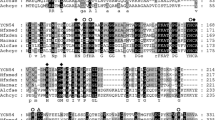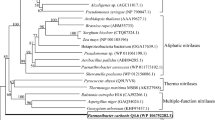Abstract
Nitrite is generated from the nitrogen cycle and its accumulation is harmful to environment and it can be reduced to nitric oxid by nitrite reductase. A novel gene from Bacillus firmus GY-49 is identified as a nirK gene encoding Cu-containing nitrite reductase by genome sequence. The full-length protein included a putative signal peptide of 26 amino acids and shown 72.73% similarity with other Cu-containing nitrite reductase whose function was verified. The 993-bp fragment encoding the mature peptide of NirK was cloned into pET-28a (+) vector and overexpressed as an active protein of 36.41 kDa in the E.coli system. The purified enzyme was green in the oxidized state and displayed double gentle peaks at 456 and 608 nm. The specific activity of purified enzyme was 98.4 U/mg toward sodium nitrite around pH 6.5 and 35 °C. The K m and K cat of NirK on sodium nitrite were 0.27 mM and 0.36 × 103 s−1, respectively. Finally, homology model analysis of NirK indicated that the enzyme was a homotrimer structure and well conserved in Cu-binding sites for enzymatic functions. This is a first report for nitrite reductase from Bacillus firmus, which augment the acquaintance of nitrite reductase.
Similar content being viewed by others
References
Abraham ZH, Lowe DJ, Smith BE (1993) Purification and characterization of the dissimilatory nitrite reductase from Alcaligenes xylosoxidans subsp. xylosoxidans (N.C.I.M.B. 11015): evidence for the presence of both type 1 and type 2 copper centres. Biochem J 295:587–593. https://doi.org/10.1264/jsme2.ME11310
Abraham ZHL, Smith BE, Howes BD, Lowe DJ, Eady RR (1997) pH dependance for binding a single nitrite ion to each type-2 Cu center in the Cu-containing nitrite reductase of Alcaligenes xylosoxidans. Biochem J 324:511–516
Alvarez L, Bricio C, Blesa A, Hidalgo A, Berenguer J (2014) Transferable denitrification capability of Thermus thermophilus. Appl Environ Microbiol 80:19–28. https://doi.org/10.1128/AEM.02594-13
Arnold K, Bordoli L, Kopp J, Schwede T (2006) The SWISS-MODEL Workspace. A web-based environment for protein structure homology modelling. Bioinformatics 22:195–201. https://doi.org/10.1093/bioinformatics/bti770
Berks BC, Ferguson SJ, Moir JW, Richardson DJ (1995) Enzymes and associated electron transport systems that catalyse the respiratory reduction of nitrogen oxides and oxyanions. Biochim Biophys Acta 1232:97–173. https://doi.org/10.1016/0005-2728(95)00092-5
Boulanger MJ, Murphy ME (2002) Crystal structure of the soluble domain of the major anaerobically induced outer membrane protein (AniA) from pathogenic Neisseria: a new class of copper-containing nitrite reductase. J Mol Biol 315:1111–1127
DeLano WL (2002) The PyMOL molecular graphics system. De Lano Scientific, San Carlos. http://www.pymol.org/
Dodd FE (1995) Evidence for two distinct azurins in Alcaligenes xylosoxidans (NCIMB 11015): potential electron donors to nitrite reductase. Biochemistry 34:10180–10186. https://doi.org/10.1021/bi00032a011
Dulley JR, Grieve PA (1975) A simple technique for eliminating interference by detergents in the lowry method of protein determination. Anal Biochem 64:136–141. https://doi.org/10.1016/0003-2697(75)90415-7
Emanuelsson O, Brunak S, Heijne G, Nielsen H (2007) Locating proteins in the cell using TargetP, SignalP and related tools. Nat Protoc 2:953–971. https://doi.org/10.1038/nprot.2007.131
Ezzine M, Ghorbel MH (2006) Physiological and biochemical responses resulting from nitrite accumulation in tomato (Lycopersicon esculentum Mill. cv. Ibiza F1). J Plant Physiol 163:1032–1039. https://doi.org/10.1016/j.jplph.2005.07.013
Ferroni FM, Marangon J, Neuman NI, Cristaldi JC, Brambilla SM, Guerrero SA, Rivas MG, Rizzi AC, Brondino CD (2014) Pseudoazurin from Sinorhizobium meliloti as an electron donor to copper-containing nitrite reductase: influence of the redox partner on the reduction potentials of the enzyme copper centers. J Biol Inorg Chem 19:913–921
Fukuda Y, Tamada T, Takami H, Suzuki S, Inoue T, Nojiri M (2011) Cloning, expression, purification, 3D-structure crystallization and preliminary X-ray crystallographic study of GK0767, the Cu-containing nitrite reductase from Geobacillus kaustophilus. Acta 3D-structurelogr F67:692–695. https://doi.org/10.1107/S1744309111013297
Fukuda Y, Koteishi H, Yoneda R, Tamada T, Takami H, Inoue T, Nojiri M (2014) Structural and functional characterization of the Geobacillus Cu nitrite reductase: Involvement of the unique N-terminal region in the interprotein electron transfer with its redox partner. Biochim Biophyc Acta 183:7396–7405. https://doi.org/10.1016/j.bbabio.2014.01.004
Godden JW, Turley S, Teller DC, Adman ET, Liu MY, Payne WJ, Gall JLe (1991) The 2.3 Å X-ray structure of nitrite reductase from Achromobacter cycloclastes. Science 253:438–442. https://doi.org/10.1126/science.1862344
Gouet P, Courcelle E, Stuart DI, Metoz F (1999) ESPript: analysis of multiple sequence alignments in PostScript. Bioinformatics 15:305–308
Hira D, Toh H, Migita CT, Okubo H, Nishiyama T, Hattori M, Furukawa K, Fujii T (2012) Anammox organism KSU-1 expresses a NirK-type copper-containing nitrite reductase instead of a NirS-type with cytochrome cd1. 586(11):1658–1663. https://doi.org/10.1016/j.febslet.2012.04.041
Hoffmann T, Frankenberg N, Marino M, Jahn D (1998) Ammonification in Bacillus subtilis utilizing dissimilatory nitrite reductase is dependent on resDE. J Bacteriol 180:186–189
Inatomi K, Hochstein LI (1996) The purification and properties of a copper nitrite reductase Haloferax denitrificans. Curr Microbiol 32:72–76. https://doi.org/10.1007/s002849900013
Iwasaki H, Noji S, Shidara S (1975) Achromobacter cycloclastes nitrite reductase. The function of Cu, amino acid composition, and ESR spectra. J Biochem 78:355–361
Jones CM, Stres B, Rosenquist M, Hallin S (2008) Phylogenetic analysis of nitrite, nitric oxide, and nitrous oxide respiratory enzymes reveal a complex evolutionary history for denitrification. Mol Biol Evol 25(9):1955–1966. https://doi.org/10.1093/molbev/msn146
Kabayashi K, Shoun H (1995) The copper-containing dissimilatory nitrite reductase involved in the denitrifying system of the fungus Fusarium oxysporum. J Biol Chen 270:4146–4151
Kakutani TH, Watanabe H, Arima K, Beppu T (1981) Purification and properties of a Cu-containing nitrite reductase from a denitrifying bacterium Alcaligenes faecalisstrain S-6. J Biochem 89:453 – 46
Kataoka K, Furusawa H, Takagi K, Yamaguchi K, Suzuki S (2000) Functional analysis of conserved aspartate and histidine residues located around the type 2 Cu site of Cu-containing nitrite reductase. J Biochem 127:345–350
Kobayashi M, Shoun H (1995) The Cu-containing dissimilatory nitrite reductase involved in the denitrifying system of the fungus Fusarium oxysporum. J Biol Chem 270:4146–4151
Kondo K, Yoshimatsu K, Fujiwara T (2012) Expression, and molecular and enzymatic characterization of Cu-containing nitrite reductase from a marine ammonia-oxidizing gammaproteobacterium, Nitrosococcus oceani. Microbes Environ 27:407–412. https://doi.org/10.1264/jsme2.ME11310
Kukimoto M, Nishiyama M, Murphy MEP, Turley S, Adman ET, Horinouchi S, Beppu T (1994) X-ray structure and site-directed mutagenesis of a nitrite reductase from Alcaligenes f aecalis S-6: roles of two copper atoms in nitrite reduction. Biochemistry 33:5246–5252
Ladunga I (2002) Finding homologs to nucleotide sequences using network BLAST searches. Curr Protoc Bioinform. https://doi.org/10.1002/0471250953.bi0303s00
LaCroix LB, Shadle SE, Wang Y, Averill BA, Hedman B, Hodgson KO, Solomon EI (1996) Electronic structure of the perturbed blue copper site in nitrite reductase: a spectroscopic properties, bonding, and implications for the entatic/rack state. J Am Chem Soc 118:7755–7768
Leferink NG, Pudney CR, Brenner S, Heyes DJ, Eady RR, Samar Hasnain S, Hay S, Rigby SE, Scrutton NS (2012) Gating mechanisms for biological electron transfer: Integrating structure with biophysics reveals the nature of redox control in cytochrome P450 reductase and Cu-dependent nitrite reductase. FEBS Lett 586:578–584. https://doi.org/10.1016/j.febslet.2011.07.003
Li Y, Hodak M, Bernholc J (2015) Enzymatic mechanism of copper-containing nitrite reductase. Biochem 54:1233–1242. https://doi.org/10.1021/bi5007767
Lintuluoto M, Lintuluoto JM (2016) DFT study on nitrite reduction mechanism in copper-containing nitrite reductase. Biochem 55:210–223. https://doi.org/10.1021/acs.biochem.5b00542
Liu MY, Liu MC, Payne WJ, Legall J (1986) Properties and electron transfer specificity of copper proteins from the denitrifier “Achromobacter cycloclastes”. J Bacteriol 166:604–608
MacPherson IS, Murphy ME (2007) Type-2 Cu-containing enzymes. Cell Mol Life Sci 64:2887–2899
Mania D, Heylen K, van Spanning RJ, Frostegard A (2014) The nitrate-ammonifying and nosZ-carrying bacterium Bacillus vireti is a potent source and sink for nitric and nitrous oxide under high nitrate conditions. Environ Microbiol 16:3196 – 210. https://doi.org/10.1111/1462-2920.12478
Martinez-Espinosa RM, Marhuenda-Egea FC, Bonete MJ (2001) Purification and characterization of a possible assimilatory nitrite reductase from the halophile archaeon Haloferax mediterranei. FEMS Microbiol Lett 196:113–118. https://doi.org/10.1111/j.1574-6968.2001.tb10550.x
Nicholas DJD, Nason A (1957) Determination of nitrate and nitrite. Methods Enzymol 3:981–984
Nojiri M, Koteishi H, Nakagami T, Kobayashi K, Inoue T, Yamaguchi K, Suzuki S (2009) Structural basis of inter-protein electron transfer for nitrite reduction in denitrification. Nature 462:117–120. https://doi.org/10.1038/nature08507
Prudencio M, Eady RR, Sawers G (1999) The blue copper-containing nitrite reductase from Alcaligenes xylosoxidans: cloning of the nirA gene and characterization of the recombinant enzyme. J Bacteriol 181:2323–2329
Santoro AE, Boehm AB, Francis CA (2006) Denitrifier community composition along a nitrate and salinity gradient in a coastal aquifer. Appl Environ Microbiol 72:2102–2109. https://doi.org/10.1128/AEM.72.3.2102-2109.2006
Suzuki S, Kataoka K, Yamaguchi K, Inoue T, Kai Y (1999) Structure function relationships of Cu-containing nitrite reductases. Coord Chem Rev 190–192:245–265
Thompson JD, Higgins DG, Gibson TJ (1994) CLUSTALW: improving the sensitivity of progressive multiple sequence alignment through sequence weighting, position-specific gap penalties and weight matrix choice. Nucleic Acids Res 22:4673–4680
Tiedje JMZ (1988) Ecology of denitrification and dissimilatory nitrate reduction to ammonium. In: Zehnder AJB (ed) Environmental microbiology of anaerobes. Wiley, New York, pp 179–244
Timmons AJ, Symes MD (2015) Converting between the oxides of nitrogen using metal ligand coordination complexes. Chem Soc Rev 44:6708–6710
Tocheva EI, Rosell FI, Mauk AG, Murphy ME (2004) Side on copper nitrosyl coordination by nitrite reductase. Science 304:867–870
Verbaendert I, Boon N, De Vos P, Heylen K (2011) Denitrification is a common feature among members of the genus Bacillus. Syst Appl Microbiol 34:385–391. https://doi.org/10.1016/j.syapm.2011.02.003
Wijma HJ, Jeuken LJC, Verbeet MP, Armstrong FA, Canters GW (2006) A random-sequential mechanism for nitrite binding and active site reduction in copper-containing nitrite reductase. J Biol Chem 281:16340–16346
Author information
Authors and Affiliations
Corresponding author
Electronic supplementary material
Below is the link to the electronic supplementary material.
Rights and permissions
About this article
Cite this article
Gao, H., LI, C., Ramesh, B. et al. Cloning, purification and characterization of novel Cu-containing nitrite reductase from the Bacillus firmus GY-49. World J Microbiol Biotechnol 34, 10 (2018). https://doi.org/10.1007/s11274-017-2383-6
Received:
Accepted:
Published:
DOI: https://doi.org/10.1007/s11274-017-2383-6











